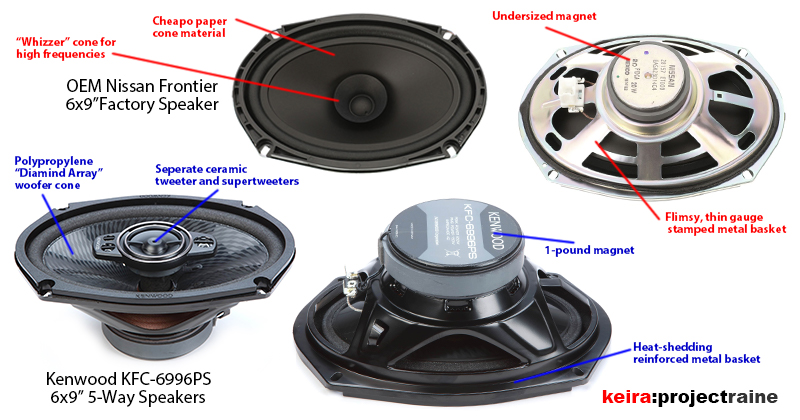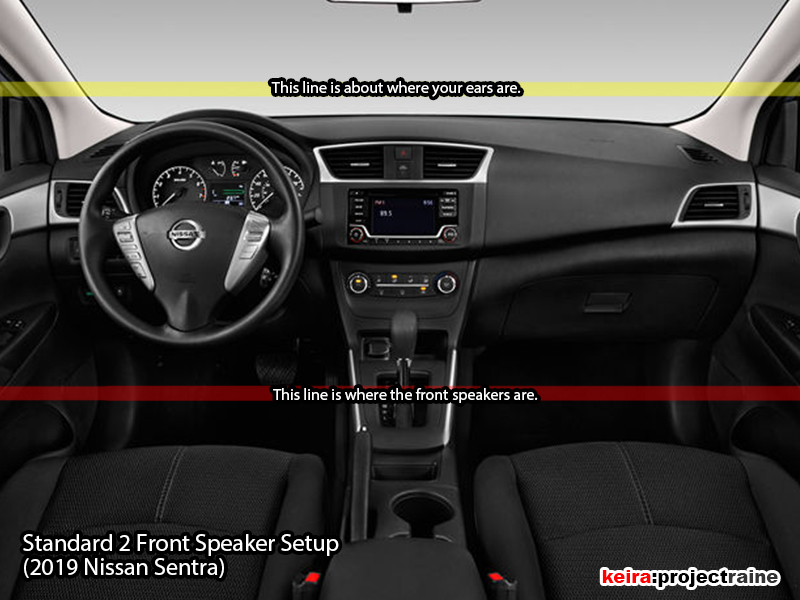Audio Upgrade Guide, Part 2: Speak(er) the Right Way

PART 2: Speak(er) the Right Way
a.k.a. Aftermarket Components are the way to go.
When it comes to upgrading the Nissan Frontier’s speakers, you’ll see many owners jump the gun and go with what is quick and easy: check the OEM door speaker sizes on the Internet, head to their nearest Best Buy (lol), and buy whatever bolt-on speaker the salesman talks them into. They get home, check the forums for how to install, and when they’re done… they feel like they have really good audio now, or at least convince themselves they do because hey – if they just spent money and took the time to install brand name door speakers – it has to be better sounding… right?
Probably yes, but not by much. Swapping the door speakers was a good start, but at the same time, you also made the mistake of not taking advantage of your Nissan Frontier’s OEM speaker arrangement! Before I get to that, let’s take a quick look at the OEM speakers, and why you made a good decision by wanting to swap them out to begin with.
Multi-Driver Speakers = Partial Upgrade
Take a look at a few quick differences between the OEM factory Nissan speakers that came with your Frontier vs. a typical multi-driver upgrade from Kenwood:

The OEM factory speaker was made to the bare minimum, to output sound at the lowest cost possible. The undersized magnet is just strong enough to move the cheap paper speaker cone. Most importantly, there is no actual tweeter for highs! The OEM speaker uses the same cone to produce high frequencies as it does the midrange. Think about that – if you’re using the same cone to produce high and midrange, what happens when the music has both at the same time? Your single-cone speaker cannot produce two different frequencies at once, so it ends up playing something blurred in between. That means your audio is no bueno.
On the contrary, a multi-driver speaker like the Kenwood 6×9”s above features multiple high-frequency drivers (the tweeter and super tweeters up top) and a separate “middle/main” frequency driver (the large woofer cone down below). Separating these drivers means they can play separate frequencies at the same time, for more audio clarity and cleaner sound. The highs will be crisp and the midrange will be more defined.
But WAIT – even though having multiple drivers in one speaker assembly makes installation a snap, the downside (and why I called it a “partial upgrade” is that with this type of configuration, the multiple drivers are all compromised to work in a shared space. Take a look below for a visual example:

Notice how you have both high frequencies (in red) and mid/low frequencies (in blue) trying to push the sound out from the same space? This causes what is referred to as “frequency interference” and the result is compromised sound clarity. To visualize why this is not ideal, imagine that you are sitting in a chair, and there is a 20-piece orchestra in front of you… but the orchestra members are all sitting in a straight, single-file line with one person behind the other. Yes, you’ll still hear all of the instruments playing, but the sound will be all jumbled together with no depth or clarity.
So How is a Component Speaker System Better?
Enter the “Component Speaker System”. A component speaker system uses separated drivers to produce separate portions of the sound. Similar to the multi-driver speaker above, a 2-way component system is also made up of a tweeter and a midrange driver. However, a component system differs from a multi-driver speaker in that the drivers are completely separate components (not attached) and can be mounted in separate locations. The advantage of a component system is that you can mount each driver separately where each driver can best do their job without interference from the others, as illustrated below:

Completely separate component systems can work seamlessly together for a wider frequency range that in turn gives your music more clarity (imagine the same orchestra, but with everyone spread out across the stage) and without overlapping frequency output as they would with the multi-driver design.
Already… Ready for Components
Okay, let’s think about your average regular passenger vehicle with standard audio. For example: in something like a 2019 Sentra, the vehicle will most likely just have 2 front speakers (one in each door panel) as shown below:

Look how far the speakers are positioned relative to where your ears are! I’m pretty sure you don’t drive with your head jammed under the steering wheel. So already this simply illustrates that even if you install good aftermarket multi-driver speakers in these OEM locations, you know what gets to hear most of the good tunes?
Your ankles.
Now compare the above with the more ideal 2nd Gen Nissan Frontier’s front speaker locations:

The advantage of the Nissan Frontier’s OEM audio configuration is that from the factory it already has two extra/higher speaker locations up front! Instead of having just a multi-driver speaker in the lower door panels (like many cars and trucks with standard audio), Nissan Frontiers have those extra speaker mounting locations up high in the corners of the dashboard which just so happen to also be closer to your ear level height. In other words: the Frontier already has provisions to install a component system! While not exactly perfect (the dash locations are aiming upward, not directly toward you), it still means you can get many of the advantages that a component system offers by swapping the OEM door panel speakers to an aftermarket component midrange driver and the dash panel speakers to an aftermarket tweeter. But what exactly is this advantage? It has to do with frequency directionality. Yes, another car audio term that sounds complicated, but I’ll explain what it means next.
What the Hell is “Frequency Directionality”?
Without making it too complicated – lower frequencies (like bass) don’t radiate in much of a specific direction; in other words, the human ear generally cannot pinpoint the physical direction from where low-frequency bass is coming from (this is why you don’t necessarily hear the bass, but you feel it). Midrange frequencies (like voices) start to have a direction – meaning if you listen hard enough, you might be able to pinpoint where the speaker is that is putting out these middle frequencies – think of these like a spotlight. Finally, high frequencies (like high-pitched bells) that are very directional. They have to be aimed in the direction your ear is – think of high frequencies like a laser pointer:

The above illustrates a few key audio things that you might not have realized or noticed before:
- Anything producing low frequencies can be put anywhere because the low frequencies will radiate outward like waves when you drop a rock into a lake. This is why it doesn’t matter where a subwoofer is installed – it can be in the trunk or the back of a hatch or under a rear seat – regardless, you’ll still hear (and feel) bass.
- The midrange is where most of the music will be. Voices, guitars, pianos, – these mid frequencies are “the meat” of the sound, and they start to require direction. That’s why midrange speakers are generally aimed directly at the listener, or as close to the direction of the listener as possible (like speakers in the doors).
- Finally, tweeters are the highest of the high frequencies. They are usually high-pitched sounds like bells or cymbals and are very directional. Because they’re very directional, you’ll want tweeters aimed toward where your ears are to hear the sounds clearly.
So, in conclusion, this is why component systems are not only better than multi-driver speakers – but also because your Nissan Frontier is ready for you to easily install them. Having the right speaker setup upfront is critical because it is the foundation for what ultimately is the goal of upgrading your audio system: a proper sound stage.
In Part 3 of this series, you’ll learn what a proper “sound stage” is, as well as why rear speakers are NOT for sound quality. HINT: No one faces away from the band.
Links to All Parts of the Audio Guide
Intro: Your OEM Stereo Sucks.
Part 1: It All Starts With the Source.
Part 2:Speak(er) the Right Way. (this post)
Part 3: You Don’t Drive From the Back Seat.
Part 4: Dogs Underwater
Part 5: Less is More
Part 6: More is Less?
Part 7: Separation Anxiety
Part 8: Time Travel… While Standing Still
Part 9:Partial Means… You’re Not Done
Part 10 Finale: At the End… Here’s 10 (Things to Know)